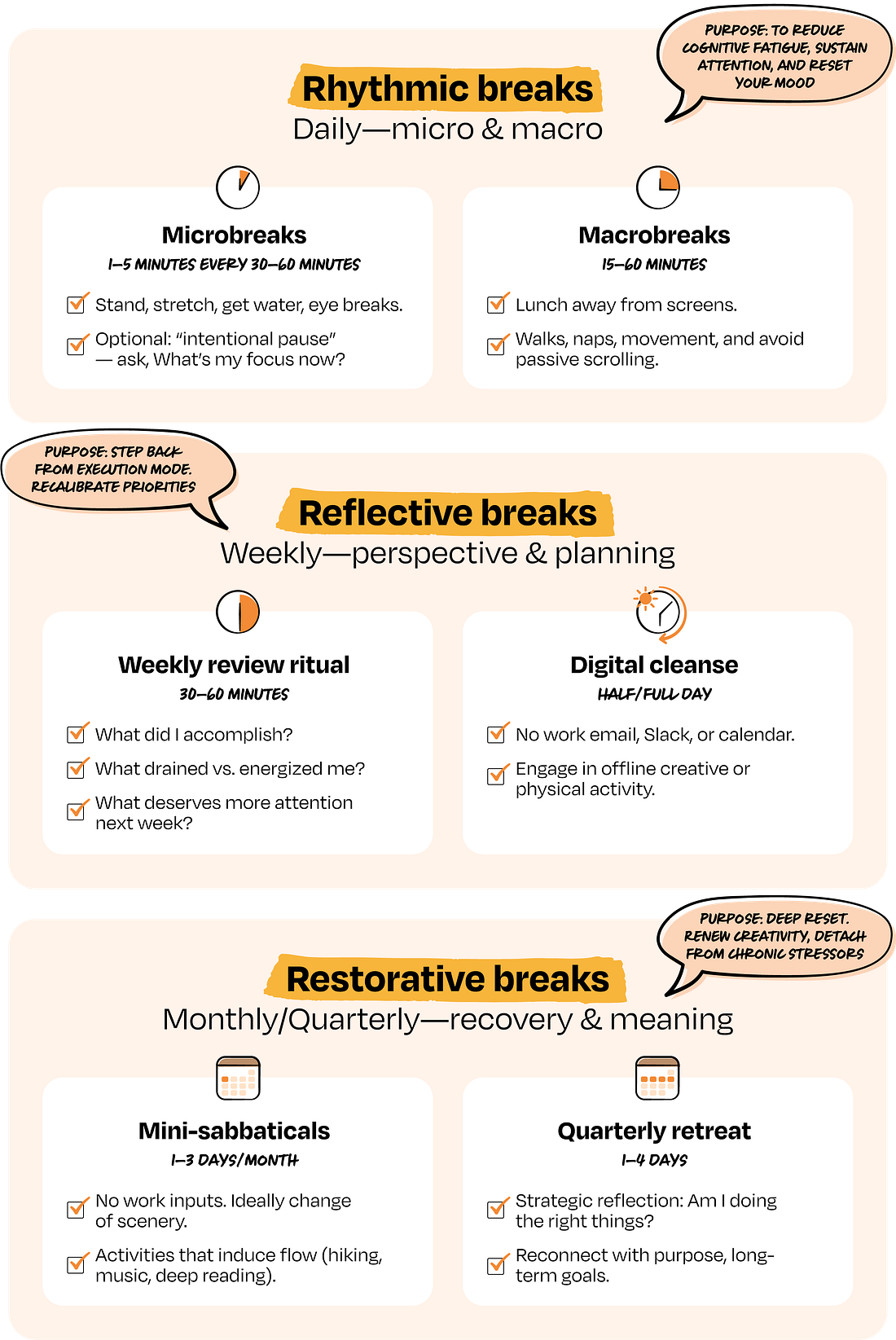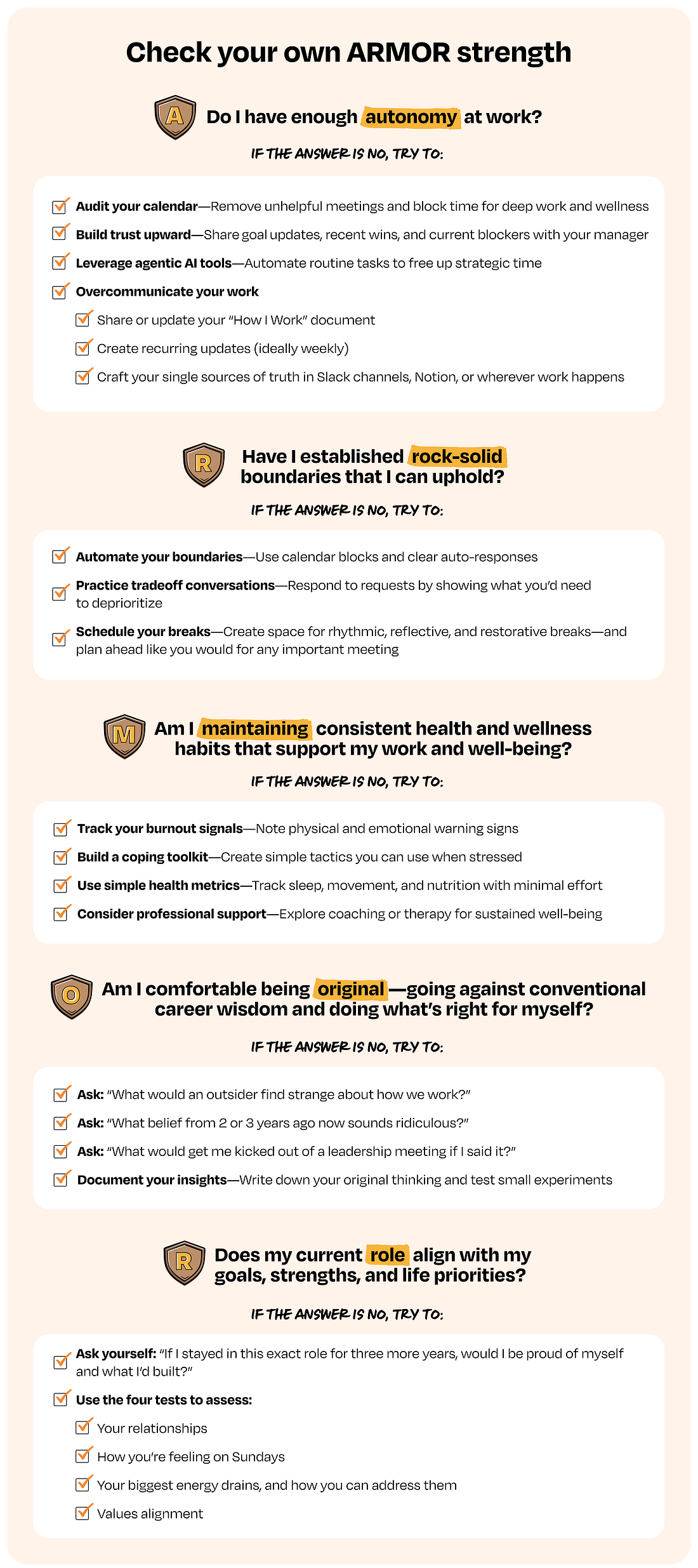How tech’s most resilient workers handle burnout
How tech’s most resilient workers handle burnoutIntroducing ARMOR: a new framework building on our tech worker sentiment survey insights👋 Welcome to a 🔒 subscriber-only edition 🔒 of my weekly newsletter. Each week I tackle reader questions about building product, driving growth, and accelerating your career. For more: Lenny’s Podcast | How I AI | Lennybot | Lenny’s Reads | Courses | Swag Annual subscribers now get a free year of Bolt, Perplexity Pro, Notion, Superhuman, Linear, Granola, and more. Subscribe now. Three weeks ago, we shared the results of our first-ever large-scale tech worker sentiment survey. The post generated tons of conversations, in particular about burnout. Readers asked, “Who are these people who aren’t burned-out?” So we decided to do a timely follow-up investigation to find out the common threads among respondents who:
We ran open-ended, video-based surveys with about 175 respondents and interviewed about 15 people who reported low to no burnout in the original survey. Our respondents revealed that dealing with burnout isn’t simply about resilience or stress management. The key is to systematically design a career and lifestyle that make burnout structurally unlikely. We call tech workers who manage to do this “burnout conquerors.” P.S. If you prefer, you can listen to this post in convenient podcast form: Spotify / Apple / YouTube. Introducing ARMOR: five shields against burnoutMy investigation revealed five core strategies for dealing with burnout. These strategies are the armor that tech workers are donning to protect themselves from burnout. A: AutonomyMany people we heard from immediately identified that autonomy is a critical ingredient to being happy at work. We also saw this again and again in our research.
Burnout conquerors continuously strive to create as much autonomy over their work lives as possible. Here’s how: 1. Proactively take control of your time and effortsBurnout conquerors keep a keen eye on how they spend their time and energy at work to make sure they’re working smarter, not harder. An open block in their calendar to do deep work isn’t just going to drop in from the sky. Their most productive hours aren’t going to magically become available for priority work. Burnout conquerors make their days their own.
2. Hit your goals to build trustRather than expecting trust in the workplace, burnout conquerors earn it by consistently delivering regardless of the external circumstances. The more you deliver on what you promised, the more everyone will trust you and leave you alone to do what you need to do. But that trust is not granted; it’s earned through behavior and successes (which is accomplished by taking control of time!).
To get this done, burnout conquerors focus on small sets of quality outcomes driven by highly targeted goals, which they communicate up, down, and all around. 3. Overcommunicate your needs to others—and yourselvesBurnout conquerors understand their own needs and communicate them clearly and appropriately to the people around them. They know that when people know what to expect of you, they are rarely caught off-guard and feel more comfortable letting you take the wheel. A common tactic for burnout avoidance we heard is to “overcommunicate” about everything. That includes far more than just what you’re working on and what resources you need to get it done.
Burnout conquerors overcommunicate how to best work with them and how they like to communicate, receive feedback, and make decisions. Set the foundations of those conversations with a “How I Work” document. Find a template here. (Also, learn to manage up generally.) R: Rock-solid boundariesBurnout conquerors know that to ruthlessly protect their time and energy, they need to erect boundaries that can withstand the pressure of a fast-paced and results-driven workplace. Here’s how: 1. Set, automate, and, yes, overcommunicate clear work-life boundariesBurnout conquerors create consistent time-based (e.g. “I’m ending the day at 6 p.m. to be with my kids”) or task-based (e.g. “I’ll focus on 3 to 5 essential and urgent tasks each day”) hard stops. Anything beyond that time or list gets pushed to another time (or delegated to AI agents).
To ensure that those boundaries hold, the people we heard from automate their after-hours responses and set clear calendar blocks, so people get notified when they’re unavailable. They also share their working schedule with their colleagues up front, including daily constraints and personal needs, and then as needed when those boundaries get tested (which they always do). 2. Get comfortable saying noBoundaries will always get tested by new requests or projects—some of which are exciting and seriously appealing! But there’s always an opportunity cost. Burnout conquerors understand that saying yes to something means saying no to something else. They reframe no’s as tradeoffs—to themselves and others.
3. Take real breaks: rhythmic, reflective, restorativeBreaks are necessary and reasonable for the roles and responsibilities we all have in this industry. Performing at a high level is essential at work, but turning off is too.
We heard a lot about the types of breaks that are successful in helping people prevent burnout. We categorized them into three types. M: Maintenance ritualsBurnout conquerors treat their health and wellness as critical professional infrastructure. We’ve all seen the advice on walking 10,000 steps a day or trying to get 7 to 8 hours of sleep. But the people in tech who are beating burnout go one level deeper. Here’s how: 1. Develop powerful “early warning” abilitiesBurnout conquerors are incredibly in tune with the physical and emotional signals of burnout. They’re listening to the body’s stress indicators, aware of energy levels and mood changes, and carefully log sleep disruptions, tension, and other manifestations, like low energy.
When people understand their baseline, they can detect when something’s off internally sooner than others might. The faster they know something’s wrong, the faster they can make it right. 2. Monitor your health signals, maintain your wellnessTo keep that early-warning system sharp, burnout conquerors track all the things, like their sleep, nutrition, and exercise. But interestingly, our participants don’t get overly technical about tracking. They use heuristics: Sleep:
Nutrition:
Exercise:
Wellness is treated as a non-negotiable business need, not optional self-care. No weeks off, scheduled sleep times, and a strong focus on consistency and intensity. Many of the exercise routines participants shared felt more like Dwayne “The Rock” Johnson’s than a tech worker’s exercise routine: weights 5 or 6 times a week, marathon training, mindfulness retreats, biohacking. Burnout conquerors are spending significant time outside of work in training.
3. Be open to all forms of therapyIt really stood out in the data that burnout conquerors seem comfortable connecting with their emotions, going to therapy, and taking leave when necessary. Many of our participants consider therapy and mental health support as preventive care. They ignore stigmas around such support and leverage their companies’ mental health benefits to the fullest. “My secret weapon against burnout is rest and time away from work. I requested a mental health leave of absence this fall . . . I sought out additional mental health support. One thing that I learned how to do in the mental health program was to check in daily with my emotions.” O: Original thinkingBurnout conquerors don’t accept conventional organizational expectations of employees. They don’t buy into the common corporate narrative that puts the onus on employees to deal with burnout. And they don’t feel guilty if they’re feeling bad or in need of a break. The people who are actively preventing burnout have a strong belief system that insulates them from falling victim to burnout-related organizational mind games. Here’s how: 1. Understand that burnout isn’t your faultWhile burnout conquerors take actionable steps toward preventing burnout in their own lives, they also know that the kind of deep exhaustion so many in the industry are feeling should not be blamed on the people suffering from it. Burnout is “organizational warfare,” not a personal responsibility.
The system is broken, and it’s not your job to fix yourself to fit a toxic system. 2. Don’t assume that working harder always yields better results (karma’s involved)Burnout conquerors reject the fundamental meritocracy belief of tech—that effort directly correlates to outcomes. Instead, they embrace uncertainty, karma, and trusting that “things work out” regardless of individual grinding.
3. Feel feelings instead of optimizing them awayBurnout conquerors don’t buy into the optimization culture of tech. When bad feelings arrive—and they always do at some point—they know it’s never more efficient to push them away to try to maximize consistent output. Instead, as one respondent says, “sometimes you need to just be human and feel terrible for a while.”
R: Role architectureBurnout conquerors design their careers strategically from day one. That means choosing the right company and the right role. To make these decisions, burnout conquerors have rubrics for evaluating the best match for their needs. Here’s how: 1. The relationship testBurnout conquerors realize that they can only thrive in an environment where they’re surrounded by people they want to be surrounded by.
2. The Sunday testThey follow their gut feelings and take the “Sunday scaries” seriously. If they’re excited for the challenge of the next week and looking forward to working with colleagues, those are great signs. If they’re not . . . it’s not.
3. The energy testThey optimize for “energy production.” Burnout conquerors seek meaning, challenge, and balance in their jobs and careers.
4. The values alignment testThey reflect on what they really, really want, applying the “Five Whys” framework to their career. They don’t get enamored by shiny objects but, rather, focus on how a company’s culture aligns with their core values.
A final piece of advice: Your work reality can only be as good as your relationshipsThe last question in my survey or interview was “What’s THE career choice that’s helped you avoid getting burned-out?” One set of responses stood out to me: how critical it is to prioritize people and relationships at home and at work. In one of my interviews, I spoke to Joshua Herzig-Marx. He told me that for him, partner or spouse involvement is crucial for managing burnout. His partner is a sounding board and collaborator. To him, solo burnout management is like trying to product manage without partnering with stakeholders. Partnership enables perspective sharing, empathetic listening, and brainstorming solutions. There was also a consensus among our burnout conquerors that, at work, who you surround yourself with matters more than anything else.
Check your own ARMOR strengthTo find out how protected you are from the burnout that’s affecting the majority of tech workers, answer these questions for yourself now and any time you feel those feelings creeping in: If you’d like to assess your burnout, take our burnout check here. And if you answered no to the above questions, tried the suggestions from our burnout conquerors, and are still dragged down by that wiped-out feeling, it may be time to consider a bigger change. Special thanks to the nearly 200 tech professionals who shared their insights again for this follow-up research. Your candid feedback will help us deal with burnout in the tech industry. 🙏 Thank you, Noam! You can find Noam on LinkedIn and X. Have a fulfilling, productive, and non-burnout-inducing week 🙏 If you’re finding this newsletter valuable, share it with a friend, and consider subscribing if you haven’t already. There are group discounts, gift options, and referral bonuses available. Sincerely, Lenny 👋 Invite your friends and earn rewardsIf you enjoy Lenny's Newsletter, share it with your friends and earn rewards when they subscribe. |
Similar newsletters
There are other similar shared emails that you might be interested in:





